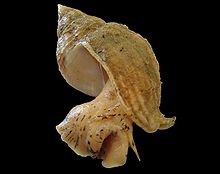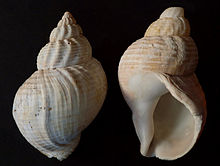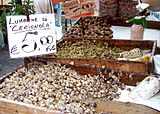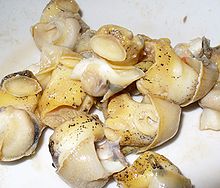- Buccinum undatum
-
Buccinum undatum
Temporal range: 28.5Mya - Present
A live individual of Buccinum undata being held up above the substrate Scientific classification Kingdom: Animalia Phylum: Mollusca Class: Gastropoda (unranked): clade Caenogastropoda
clade Hypsogastropoda
clade NeogastropodaSuperfamily: Buccinoidea Family: Buccinidae Subfamily: Buccininae Tribe: Buccinini Genus: Buccinum Species: B. undatum Binomial name Buccinum undatum
(Linnaeus, 1758)Buccinum undatum, known as the common whelk, is a large edible marine gastropod in the family Buccinidae, the "true whelks".
Contents
Distribution
This species is a familiar part of the marine fauna of the Northern Atlantic and is found on the shores of the United Kingdom, France, Norway, Iceland, some Arctic islands, and North America as far south as New Jersey.
Habitat
This species is mainly found on soft substrates in the sublittoral zone, and occasionally on the littoral fringe, where it is sometimes found alive at low tide.
 Two beach worn shells of Buccinum undatum from North Wales
Two beach worn shells of Buccinum undatum from North Wales
Shell
This species has a solid shell which is very pale. In life the shell is covered in a yellowish-brown periostracum.
The shell surface has a sculpture of vertical wavy folds (hence the name undatum, which means wavy). The wavy folds are crossed by numerous incised spiral lines, some of which are paired. The aperture of the shell is broadly oval and tapers to a siphonal canal. The number of shell whorls is seven or eight.
The maximum height of the shell is 10 cm and the maximum width is 6 cm.
The animal emits a thin and copious slime. [1]
Parasites
Larval stages of Stephanostomum baccatum were found in the digestive gland of Buccinum undatum.[2]
As a food item
Buccinum undatum are eaten widely. Some believe they are best cooked by boiling in sea water.[citation needed]
References
- ^ G.W. Tryon, Systematic Conchology vol. I, Philadelphia, 1882
- ^ Sommerville C. (1978). "The histopathology of Stephanochasmus baccatus Nicoll, 1907 in the digestive gland of Buccinum undatum (L.)". Journal of Fish Diseases 1(3): 219-232. doi:10.1111/j.1365-2761.1978.tb00024.x.
External links
- MarLIN: The Marine Life Information Network for Britain & Ireland
- R. Tucker Abbott & Percy A. Morris, 1995, Shells of the Atlantic and Gulf coasts and the West Indies, Houghton Mifflin, Boston
Commercial mollusks Marine gastropods - Abalone
- Periwinkle
- Whelk
- Buccinum undatum
- Bullacta exarata

Land and freshwater gastropods - Helix pomatia
- Helix aspersa
- Helix aperta
- Cepaea nemoralis
- Otala lactea
- Escargot
Free-swimming marine bivalves - Scallop
- Queen scallop
- Pecten maximus
- Pecten jacobaeus
- Argopecten irradians
- Placopecten magellanicus
Infaunal bivalves - Clam
- (Atlantic surf clam
- Soft-shell clam)
- Mercenaria mercenaria
- Austrovenus stutchburyi
- Saxidomus nutalli
- Arctica islandica
- Cockle
- Geoduck
- Spisula solidissima
- Paphies ventricosa
- Paphies australis
- Tuatua
- Ruditapes largillierti
- Grooved carpet shell
Sessile bivalves Freshwater bivalves Cephalopods Techniques List of fishing topics by subject Edible mollusks Bivalves Atlantic jackknife • Atlantic surf • Geoduck • Grooved carpet shell • Hard clam • Horse • Mactra stultorum • Blunt gaper • Ocean quahog • Pacific razor • Pecten jacobaeus • Venus • California butterclam • Senilia senilis • Smooth clam • Soft-shell • Triangle shell • Tuatua • Japanese littleneck • Razor clam • Pod razor • Ensis (razor genus) • PaphiesBlue • Mediterranean • New Zealand green-lipped • California • Brown • Asian/Philippine green • Date • Mytilidae (mussel family)Auckland • Eastern • Olympia • Southern mud • Colchester native • Pacific • Portuguese • Windowpane • Rock • Sydney rock • Ostra chilena/Bluff • Gillardeau oysters • Crassostrea ("true oyster" genus)Gastropods Queen • DogBlack foot opihi/Haiwaiian • China • Common European • Rayed Mediterranean • Ribbed Mediterranean • Rustic • Turtle/Talc • Yellow foot opihiLandFreshwaterNeritesInkfish Spineless • BottletailChitons Chiton magnificus • Acanthopleura granulataRelated topics: Oyster farming • Land snail farming • Categories:- Buccinidae
- Edible molluscs
- Animals described in 1758
Wikimedia Foundation. 2010.


